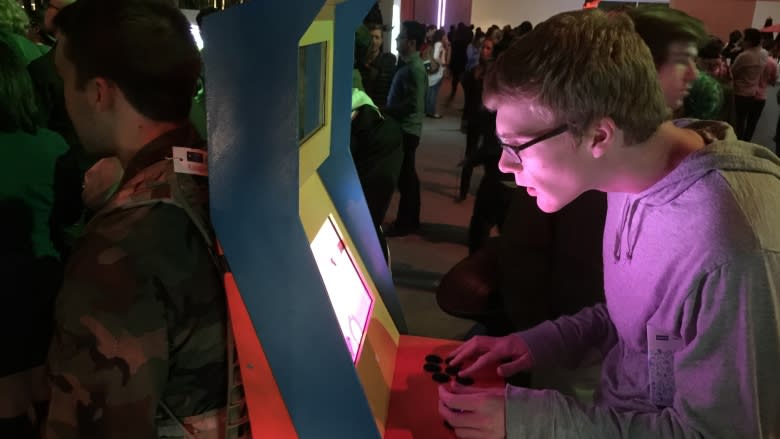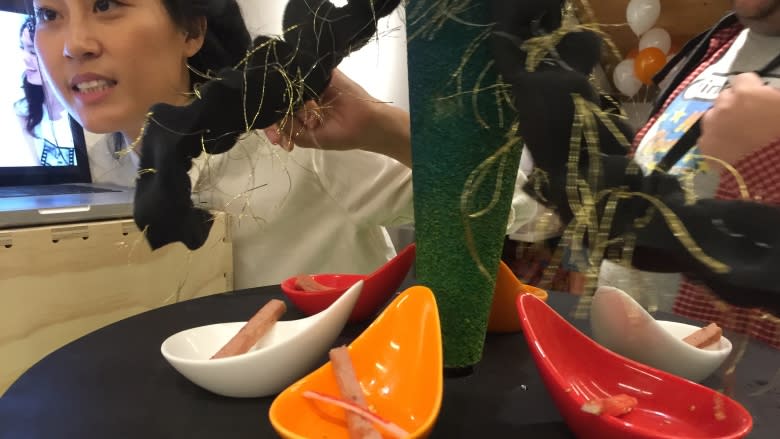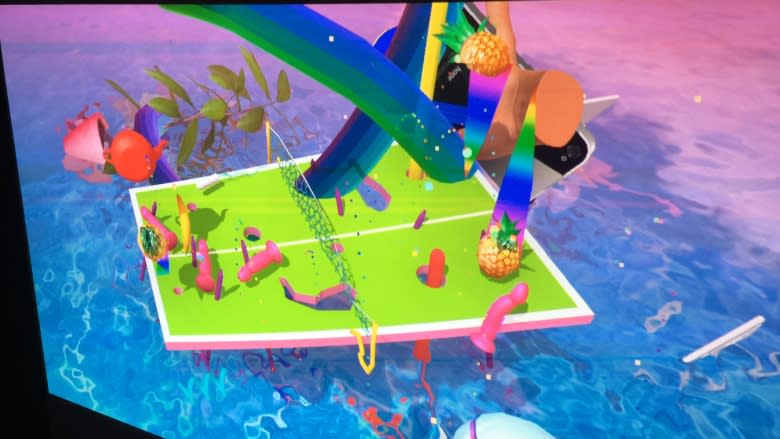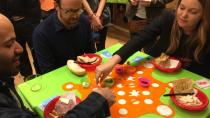Cactus joysticks among many curios at L.A. game fest
"Ow," Chris DeLeon says, wincing as he grasps the controller of his video game. "Ow."
Sure, the game is epically frustrating, but DeLeon's anguish isn't mental. His joystick is a cactus.
"Ow. I don't understand what makes it turn," DeLeon says. He tentatively holds one of the four little cacti in a small pot and wiggles it. On the screen projected in front of him, a blue face surrounded by cacti moves slowly through the desert.
But then, the pot containing his "joystick" rotates on a mechanical wheel and the cactus with the small harmless nubs slips out of his grasp and he is raked by a larger cactus with long, porcupine-like quills.
"Most cactus have a soft spot," he says. "I grabbed the one with the least spines. But sometimes it moves and that's when you get pricked. Ow. OW."
Sneaky Cactus is one of 40 games featured at the 2015 UCLA Game Art Festival. Now in its fourth year, the event held at the Hammer Museum in Los Angeles is a mix of groundbreaking experimental games and game-based art — part convention, part imaginarium.
Holla' Pain Yo forces contestants to drink jalapeño water. Puff encourages smokers to trade items for cigarettes. Adam Killer is a first-person shooter game. The target: an infinite number of Adams all standing in a row, waiting to be mowed down.
"No clue what's happening," Derek Abila says. "I'm trying to figure it out." He blows away another Adam, easily his 20th. "I don't know if there's a specific Adam you have to kill?"
There isn't. Randomness is the point. Like most of the games here, it's about the act of gaming itself.
Little chance of being played elsewhere
"We want to bridge games with contemporary art, with communities, with the makers of aesthetic art, with the media," says Eddo Stern, the festival's director. He's also a professor of design media arts at UCLA and a video game designer himself. He curated this mix of the surreal and the absurd, assembling a lineup of games that he says have almost no chance of being played outside these walls.
"It's like going to the theatre or an art museum," Stern says. "This isn't a trade show."
There's a station where players roll dice in order to steal sandwiches from each other. Walking by is the human arcade. The game is mounted on the artist's back and gamers play as he walks. Then a 40-foot plush orange noodle snakes through the museum courtyard. Whenever anyone squeezes it, hidden sensors react to create a soundtrack and a 3D projection on a distant screen.
In the food games section, I watch as a young woman tries to grab ingredients from beneath a spinning green plastic creature with two legs and hairy gold filaments. The description beneath Ddook Ddak Kimbap! reads: "Two teams attempt to build a spring roll by stealing ingredients out from underneath the Dokkaebi's tentacles."
The Dokkaebi, says its designer, Camella DaEun Kim, is a mystical being from Korean folklore, often pictured with a spiky wand. "The goal is to open a new idea of a relationship between food and games: how you eat, when you want to eat," Kim says.
The woman who's playing succeeds in snatching a piece of Spam from the plate. She pops it into her mouth before Kim can tell her the food is for demonstration purposes only. But at least the game's objective is obvious. Others are more opaque.
"I think that's a bunch of trees. Wait. I'm still falling," Oscar Pascqual says. "I don't know what's happening. I think it's exploratory. I've just been walking around." He's been playing Gardenarium for 10 minutes and is more confused now than when he began.
"But I like the way it looks," he says of the serene, pastoral scenes. "It's very peaceful."
Pascqual is studying animation, and his professor suggested he check out the UCLA Game Art Festival. He says he's impressed by both the beauty of the graphic art and the creativity behind the games.
"I used to be a console game guy. Now I'm into indie games made by a small crew," Pascqual says. "I like this."
'Floodgates have opened'
The growth of the indie game movement has meant a renaissance of games that push boundaries, Eddo Stern says.
"There are more voices making games now than there were 10 years ago — women, artists, gay and lesbian. More people have access," Stern says. "And the generation now is appreciating these types of games. Now that the first generation of indie games has come and gone, the floodgates have opened."
Even though most of the games at this exhibition are too big, too messy or too weird to be sold, one or two may yet find a market.
One game stands out because of its beautiful graphics; the characters look more Disney than indie. On the screen, dolphins are seated at school desks. They appear to be taking a test. The man behind Classroom Aquatic is Remy Karns, a video game design student at the University of Southern California in L.A.
"It's about an exchange student in a school of dolphins," Karns says. "He's taking a test but he's not prepared. So he has to cheat."
It's controlled by the Oculus Rift virtual reality headset. The player moves his head to look around the classroom, and leans one way and the other to see the answers on the dolphins' tests. Karns says despite its innocuous premise, players have told him they find it scarier than many violent games.
"You've never really run from a monster or been in a war, but everyone's been in class.... Cheating is terrifying!" Karns says. "It's the first trivia game for the Oculus Rift. It captures what the medium of VR can do. It can immediately be picked up by anyone."
Karns' pitch, unlike that of most students at the festival, is polished and rehearsed. He's wearing a Classroom Aquatic T-shirt. When asked if he's planning to eventually sell the game, he tells me he's sorry but he can't answer without getting into trouble.
"We're making an announcement really soon," Karns says.
Success!
Back in the vicinity of Sneaky Cactus, I hear a young man's scream. But this time it isn't a cry of pain. Chris DeLeon has just finished the game he's playing — though he's not exactly sure why the game ended where it did.
"It wasn't as bad as I thought it would be," he says, pulling out what he believes to be a spine from his index finger. "I got to the checkpoint. I got to the bad guy."
Would he want this game in his Christmas stocking? "Absolutely not," he says, smiling. "I wouldn't want to take this home. Or even play this again."
But two minutes later, DeLeon is wiggling the cactus, heading off on another bizarre, painful quest that he still only vaguely understands.












